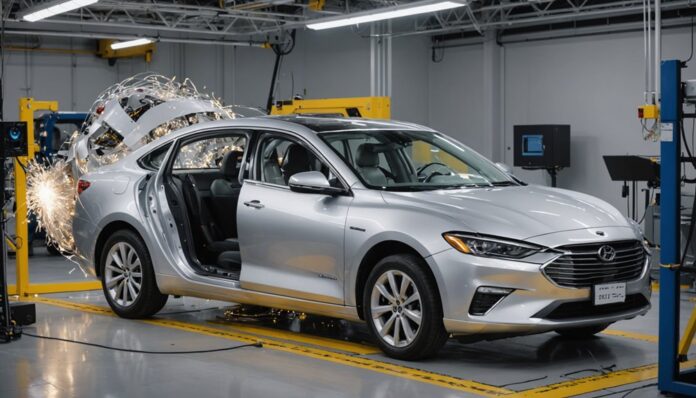Car safety ratings for 2025 are set to undergo significant changes. The National Highway Traffic Safety Administration and the Insurance Institute for Highway Safety will introduce updated evaluation criteria, incorporating real-world scenarios and advanced safety features like automated braking. Enhanced crash testing protocols will also be implemented. As a result, consumers can expect more accurate safety ratings, better reflecting a vehicle’s ability to prevent or mitigate crashes. The implications of these changes are complex.
Highlights
- Enhanced crash testing protocols and revised evaluation criteria provide more accurate safety ratings for informed vehicle purchases.
- Advanced safety features, such as automated braking, are increasingly prevalent and influence safety ratings.
- The Insurance Institute for Highway Safety (IIHS) updates testing protocols to reflect revised criteria and emphasize active safety features.
- Predictive analytics and artificial intelligence are being integrated into safety rating systems for more accurate evaluations.
- Vehicle-to-Everything (V2X) communication technology enables real-time safety updates and enhances overall safety, influencing consumer purchasing decisions.
Enhanced Crash Testing Protocols for 2025
The National Highway Traffic Safety Administration (NHTSA) has implemented enhanced crash testing protocols for 2025, aiming to further improve vehicle safety on the road.
The new protocols include crash simulation advancements, allowing for more accurate and thorough assessments of vehicle performance in a variety of crash scenarios.
Additionally, testing facility upgrades have been made to accommodate the new protocols, enabling the NHTSA to conduct more detailed and precise evaluations.
These enhancements will provide consumers with more accurate and reliable safety ratings, helping them make informed decisions when purchasing a vehicle.
The updated protocols also promote a culture of safety and responsibility among vehicle manufacturers, encouraging them to design and produce safer vehicles.
This contributes to a sense of community and shared values among road users.
The Role of Advanced Safety Features in Car Safety Ratings
As advanced safety features become increasingly prevalent in modern vehicles, their impact on car safety ratings has grown markedly.
Vehicles equipped with features such as automated braking and collision avoidance systems are now being evaluated on their ability to prevent accidents or mitigate damage. These features have been shown to greatly reduce the risk of crashes and injuries on the road.
As a result, vehicles with advanced safety features are being awarded higher safety ratings than those without. The inclusion of these features in safety ratings provides consumers with a more thorough understanding of a vehicle’s overall safety performance.
NHTSA’s Revised Evaluation Criteria
Numerous changes have been made to the National Highway Traffic Safety Administration’s (NHTSA) evaluation criteria for car safety ratings in 2025.
The revised NHTSA criteria aim to provide a more thorough assessment of a vehicle’s safety features and performance. Evaluation methods now include more stringent crashworthiness testing and improved pedestrian crash prevention ratings.
The agency has also expanded its testing protocols to include updated scenarios, such as oblique crashes. The revised criteria also place greater emphasis on advanced safety features, such as automatic emergency braking systems and lane departure warning systems.
The updated NHTSA criteria will provide consumers with a more accurate understanding of a vehicle’s safety capabilities. This revised approach will help promote safer vehicles on the road and ultimately reduce motor vehicle injuries and fatalities.
IIHS Updates: What to Expect in 2025
Building on the revised evaluation criteria introduced by the NHTSA, the Insurance Institute for Highway Safety (IIHS) has also updated its testing protocols for 2025.
The IIHS testing will now place greater emphasis on active safety features and crash prevention technologies. Additionally, the rating criteria will assess the performance of vehicles in more complex and real-world scenarios.
For instance, the updated testing protocols will simulate scenarios involving pedestrians, bicyclists, and vehicles traveling at higher speeds. The IIHS rating criteria will also consider the effectiveness of advanced safety features, such as automatic emergency braking and lane departure warning systems.
These updates aim to provide a more thorough evaluation of a vehicle’s safety capabilities.
The Impact of Driver Assistance Technologies on Safety Ratings
While vehicle safety ratings have traditionally focused on performance in crash tests, the integration of driver assistance technologies is becoming increasingly important in gauging a vehicle’s overall safety.
Advanced safety features such as automated braking and lane assistance are now being taken into consideration when evaluating a vehicle’s safety rating. These technologies have been shown to notably reduce the risk of accidents and injuries on the road.
The National Highway Traffic Safety Administration and the Insurance Institute for Highway Safety are updating their evaluation protocols to reflect the growing presence of these advanced safety features.
As a result, vehicles equipped with these technologies are likely to receive higher safety ratings, reflecting their enhanced safety performance.
How Car Safety Ratings Will Affect Vehicle Design
As car safety ratings continue to evolve, their impact on vehicle design is expected to become increasingly significant.
Vehicle manufacturers are anticipated to focus on incorporating design innovations that address the latest safety concerns and assessment protocols. Advancements in crumple zones, occupant compartments, and impact-absorbing materials are likely to become more prevalent.
Regulatory impacts will also play a vital role, as carmakers endeavor to meet or exceed the standards set by rating agencies. In response, manufacturers may adopt novel designs, such as advanced airbag systems and enhanced vehicle structures.
These changes will not only improve safety ratings but also contribute to a reduction in the number of accidents and injuries on the road. The ultimate goal is to create safer vehicles that protect occupants and other road users.
New Rating Systems for Pedestrian and Cyclist Safety
The emphasis on vehicle design and occupant safety is matched by a growing concern for the well-being of vulnerable road users, including pedestrians and cyclists.
In response, car safety ratings for 2025 will introduce new evaluation protocols for pedestrian awareness and cyclist protection. These rating systems will assess vehicles’ ability to detect and prevent accidents involving vulnerable road users.
Vehicles will be tested for their capacity to recognize pedestrians and cyclists in various scenarios, such as when they are entering the road or making turns.
The new ratings will also consider the presence of safety features such as automatic emergency braking and blind spot detection.
The Importance of Vehicle-to-Vehicle Communication in Safety Ratings
In addition to enhancements in pedestrian and cyclist safety evaluations, advancements in vehicle-to-vehicle (V2V) communication are also expected to play a significant role in determining car safety ratings for 2025.
Vehicle connectivity enables vehicles to share crucial information with each other, such as speed, position, and path, to prevent accidents. The development of standardized communication protocols allows vehicles from different manufacturers to communicate seamlessly.
The National Highway Traffic Safety Administration (NHTSA) has established communication standards to guarantee interoperability among vehicles. As V2V communication becomes more prevalent, it is likely to become a key factor in evaluating vehicle safety.
Manufacturers that incorporate this technology into their vehicles may receive higher safety ratings, reflecting their commitment to enhanced safety features.
What Car Shoppers Need to Know About 2025 Safety Ratings
Several key factors will influence car safety ratings in 2025, and understanding these changes is vital for car shoppers making informed purchasing decisions.
As safety ratings continue to evolve, consumer awareness plays a significant role in driving demand for safer vehicles. Car shoppers should be aware of the updated testing protocols and evaluation criteria used by reputable rating organizations. These changes can impact a vehicle’s safety perception, affecting its overall rating.
In addition, car shoppers should research the specific safety features and technologies included in a vehicle, such as advanced airbags and emergency braking systems.
The Future of Car Safety Ratings: Emerging Trends and Technologies
As advancements in vehicle safety continue to unfold, a fresh phase of safety ratings is emerging, driven by innovative technologies and more extensive evaluation methods.
The future of car safety ratings will likely involve increased use of automated assessments, which employ advanced sensors and artificial intelligence to simulate various crash scenarios.
Predictive analytics will also play a key role in evaluating vehicle safety, allowing for more accurate forecasting of potential safety risks.
In addition, vehicle-to-everything (V2X) communication technology will enable vehicles to share safety data with other vehicles and infrastructure, enhancing overall safety.
These emerging trends and technologies will shape the next generation of car safety ratings, providing consumers with more detailed and accurate information to inform their purchasing decisions.
Conclusion
The 2025 car safety ratings will provide consumers with a more thorough understanding of a vehicle’s safety capabilities. With enhanced crash testing protocols, advanced safety features, and revised evaluation criteria, the NHTSA and IIHS will offer more accurate and informative ratings. As technology continues to evolve, the integration of predictive analytics and V2X communication will play a vital role in shaping the future of car safety ratings, promoting a culture of safety and informed decision-making.


